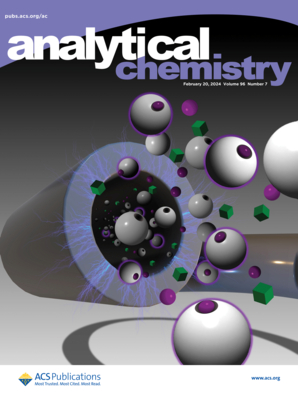Exploring Meso-Six-Membered-N-Heterocycle BODIPY Rotors as AIE Probes for Fluorescence Imaging Subcellular Viscosity in Organelles.
IF 6.7
1区 化学
Q1 CHEMISTRY, ANALYTICAL
引用次数: 0
Abstract
Aggregation-induced emission (AIE)-type small-molecular fluorescent rotors have attracted wide interest due to their inherent excellent properties in bioimaging viscosity, which can potentially reveal the relationships between microviscosity and related diseases. Although many fluorescent probes have been designed, easy-to-prepare and multifunctional AIE rotors remain a hot topic and less reported. Herein, four easy-to-prepare and water-soluble meso-pyrimidine/pyridine BODIPY-based multifunctional fluorescent probes were rationally designed to investigate the effects of the number and position of nitrogen in six-membered-N-heterocycles on viscosity, AIE, and viscosity imaging. Luckily, the meso-o-pyrimidine-based probe 1 displayed significant fluorescence enhancements at 525 nm with gradually increasing viscosity from water to glycerol, which also showed obvious AIE property in an acetonitrile/water mixture due to two nitrogen at the ortho positions of pyrimidine. Meso-o-pyridine-based 2 exhibited no viscosity-enhanced emissions, but obvious AIE enhancements appeared. Comparatively, the meso-m-pyridine-based probe 3 showed no viscosity- and aggregation-induced emission enhancements, while the meso-p-pyridine-based one 4 displayed obvious viscosity response without AIE character. Furthermore, 1 and 4 were applied to cellular imaging, which displayed lysosomal and mitochondrial localizations in HeLa cells, respectively, and successfully monitored viscosity variations induced by the addition of lipopolysaccharide (LPS) or monensin. In summary, four meso-pyrimidine and meso-pyridine-BODIPY multifunctional fluorescent rotors have been prepared using easy synthesis, in which meso-o-pyrimidine and meso-o-pyridine ones showed improved AIE properties in water, and meso-o-pyrimidine and meso-p-pyridine ones showed good subcellular localization and viscosity changes in HeLa cells. This work can provide an easy-to-prepare and useful strategy for multifunctional fluorescent probes with enhanced AIE property for imaging viscosity and other applications.探索中六元n -杂环BODIPY转子作为AIE探针在细胞器亚细胞粘度荧光成像中的应用。
聚集诱导发射(AIE)型小分子荧光转子由于其固有的优异的生物成像粘度特性而引起了广泛的关注,这可能揭示微粘度与相关疾病之间的关系。虽然已经设计了许多荧光探针,但易于制备和多功能的AIE转子仍然是一个热门话题,报道较少。本文合理设计了四种易于制备且水溶性的中介嘧啶/吡啶bodipy多功能荧光探针,研究六元n -杂环中氮的数目和位置对粘度、AIE和粘度成像的影响。幸运的是,基于中介-邻嘧啶的探针1在525 nm处显示出明显的荧光增强,从水到甘油的粘度逐渐增加,由于嘧啶的邻位上有两个氮,在乙腈/水混合物中也显示出明显的AIE特性。中介吡啶基2没有表现出粘度增强,但出现了明显的AIE增强。相比之下,基于介间吡啶的探针3没有表现出粘度和聚集诱导的发射增强,而基于介对吡啶的探针4表现出明显的粘度响应,但没有AIE特征。此外,将1和4应用于细胞成像,分别显示HeLa细胞中的溶酶体和线粒体定位,并成功监测添加脂多糖(LPS)或莫能菌素诱导的粘度变化。综上所述,我们通过简单的合成方法制备了4个介介嘧啶和介介吡啶- bodipy多功能荧光转子,其中介介-邻嘧啶和介介-邻吡啶的荧光转子在水中表现出较好的AIE性能,介介-邻嘧啶和介介-对吡啶的荧光转子在HeLa细胞中表现出良好的亚细胞定位和粘度变化。这项工作为增强AIE性能的多功能荧光探针的成像粘度和其他应用提供了一种易于制备和有用的策略。
本文章由计算机程序翻译,如有差异,请以英文原文为准。
求助全文
约1分钟内获得全文
求助全文
来源期刊

Analytical Chemistry
化学-分析化学
CiteScore
12.10
自引率
12.20%
发文量
1949
审稿时长
1.4 months
期刊介绍:
Analytical Chemistry, a peer-reviewed research journal, focuses on disseminating new and original knowledge across all branches of analytical chemistry. Fundamental articles may explore general principles of chemical measurement science and need not directly address existing or potential analytical methodology. They can be entirely theoretical or report experimental results. Contributions may cover various phases of analytical operations, including sampling, bioanalysis, electrochemistry, mass spectrometry, microscale and nanoscale systems, environmental analysis, separations, spectroscopy, chemical reactions and selectivity, instrumentation, imaging, surface analysis, and data processing. Papers discussing known analytical methods should present a significant, original application of the method, a notable improvement, or results on an important analyte.
 求助内容:
求助内容: 应助结果提醒方式:
应助结果提醒方式:


